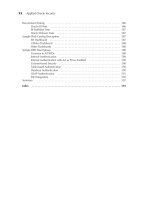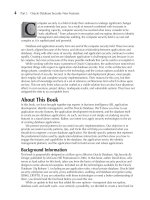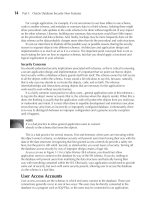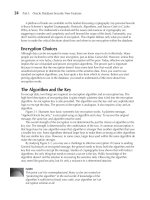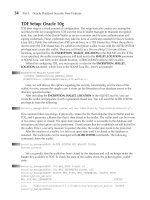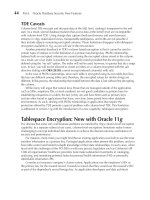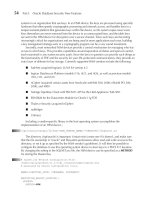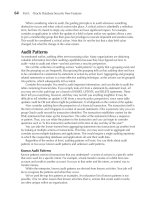Applied Oracle Security: Developing Secure Database and Middleware Environments- P5 pot
Bạn đang xem bản rút gọn của tài liệu. Xem và tải ngay bản đầy đủ của tài liệu tại đây (254.63 KB, 10 trang )
14 Part I: Oracle Database Security New Features
For a single application, for example, it’s not uncommon to see base tables in one schema,
code in another schema, and metadata or summary data in a third schema. Isolating these might
allow procedural code updates to the code schema to be done without significant (if any) impact
on the other schemas. Likewise, building new summary data structures would have little impact
on the procedural and data schemas. And, finally, backups may be more frequently done on the
data schema as the data probably changes more often than do the procedural and code structures.
It’s not our intent here to illustrate all the possible ways or possible reasons (barring the security
reason) to separate objects into different schemas. Architecture and application design and
implementation is as much an art as it is a science. The important point conveyed here is not so
much stating the laws on how to organize schemas, but that you should apply a functional and
logical organization to your schemas.
Security Concerns
You should understand security implications associated with schemas, as this is critical to ensuring
a secure application design and implementation. It’s important that we point out that no object-
level security within a database schema guards itself from itself. The schema owner has full access
to all the objects within the schema. It may sound a bit ridiculous to say this, because, naturally,
that is why you may decide to co-locate the objects, code, and so forth. The obvious
interrelationships and interactions among objects that are necessary for the application to
work need to exist without security barriers.
It is a fairly common worst practice to allow users—general application users in this reference—
to log into the object owner accounts (that is, the schemas where the objects reside). When this is
done, the thinking is usually that the application code will protect the objects from any malicious
or malevolent user intent. It is most often done to expedite development and minimize execution
errors that may arise from an incorrectly or improperly configured database. Unfortunately, there
is no way to distinguish between an improper configuration and a genuine security exception
until it happens.
NOTE
It is a bad practice to allow general application users to connect
directly to the schema that owns the objects.
This is a bad practice for several reasons. First and foremost, when users are executing within
the object owner’s schema, no database security will prevent users from having their way with the
data or the data structures (recognizing that fine-grained access controls do provide a safety net
here, but the point is still valid). Second, as stated earlier, you want layers of security. Turning off
the database access security by way of improper design creates a huge risk.
As you can see in Figure 1-1 for a Sales History (SH) schema, you should not allow
application users to connect to the database by way of the SH schema. If you do, nothing in
the database will prevent users from mutilating the data structures and basically having their
way with everything contained within the SH. Obviously, your application would need to provide
some sort of security, but even with some security present, allowing user to access the database
via the schema is a bad idea.
User Access Accounts
User access accounts are the schemas in which end users connect to the database. These user
connections generally occur in one of two ways: The users may be directly connected to the
database via a program such as SQL*Plus, or the users may be connected via an application,
Chapter 1: Security Blueprints and New Thinking 15
typically running through an application server that is utilizing some form of connection pool,
connection sharing, and/or connection cache. For simplicity, consider only that from the
database’s perspective, the end user is connected to a schema.
Dedicated Accounts and Shared Accounts
Irrespective of how the users connect, they will be connected either to a dedicated account or a
shared account. At the risk of stating the obvious, a dedicated account associates one distinct user
with one distinct account. A shared account is used when users share the same functional roles
and thus the same sets of privileges.
Security implications center around two things: user identification for auditing and accountability
purposes, and access controls to allow or prevent users from performing specific actions or accessing
specific data. From a security perspective, the simplest situation occurs when users have dedicated
accounts, because the database applies object-level security and auditing controls at the schema
level. If the user has logged in directly or used proxy authentication to a dedicated account,
maintaining user identity for accountability is accomplished by default. Additionally, you can
leverage all the native object-level security controls provided by the database to enforce access
controls on a user-by-user basis.
Given all these benefits, you may wonder why everyone doesn’t just go with dedicated
accounts as the model. The answer to this was presented earlier in our guiding principles. The
three reasons for not architecting dedicated user accounts are as follows:
1. User identity may not be known; the database invocation may be done via nested Web
services or a federated call, which is unable to convey actual end user identity.
2. User identity alone does not provide enough of a security basis for many security
decisions.
3. A one-to-one user-to-account ratio is a management nightmare.
It has long been argued that you should not allow users to share accounts. Whether you agree
with this or not, shared accounts happen quite frequently, especially when the users share
FIGURE 1-1 A security worst-practice is to allow application users to connect directly to the
schema that contains the data structures, objects, and code of the application.
16 Part I: Oracle Database Security New Features
functions and thus privileges. The scary aspect of shared accounts is that they are often applied
to administrator accounts such as root, SYS, or SYSTEM for the database. Shared accounts allow
multiple users to access the same account but in doing so, it obfuscates their unique identities.
This would therefore limit, if not altogether defeat, any auditing. If someone does something bad,
no one knows for sure who did it.
Nevertheless, shared accounts still make sense for manageability reasons, and you can
employ such techniques as setting the CLIENT_IDENTIFIER to propagate the real end user’s
identity. Another prime example on UNIX systems is the use of SUDO, which allows users to
execute privileged commands (run as root) while preserving their identity. Notionally, and
assuming that the accountability and security privileges are maintained, shared accounts are
an ideal way to proceed, which is why it is a popular model used today.
Recall the notion of creating accounts by function. One familiar example of a default account
is SYSTEM, the default DBA account for Oracle Database. Using SYSTEM, the DBA can log into
this account to conduct most administrative activities. Note that the DBA is not logging into the
SYS account unless it is absolutely necessary, as would be the case to grant privileges on a SYS-
owned object. Ideally, individual accounts are created for the DBAs, and the DBA role is granted
to each of the individual accounts. The authorizations and access controls are then based on the
privileges assigned to the DBA role, and each DBA’s identity is captured by his or her individual
logins.
Note the immediate separation between SYS and SYSTEM. SYS owns the objects; SYSTEM has
a functional role as DBA. This separation, which has been established as a precedent by Oracle
for many years, serves as the basis on which you should consider your schema designs.
Getting Started
Now you know that you should segment schemas and user accounts. Within user accounts, you
need to further divide by function and profile. One effective way to begin these tasks is to divide
the user community into four coarse-level groups. These groups are coarse-level and are intended
to be such so as to simplify the discussions. This provides the smallest, yet most prevalent, use
cases as we discuss security patterns, so the focus can be on the categorizations as opposed to
anything else.
We’ll use the term user profiles to refer to the categories in which user populations are divided.
These user profiles allow you to think about the basic requirements and then attach them to an
appropriate design pattern. Quite simply, it’s a needed first step to designing security correctly. You
should be able to use this methodology when you build and design your applications. The intent
here is not to solve or complete the design, but to provide a foundation and foundational
understanding of what needs to be done and why from a security perspective.
User Profiles
In its simplest form, four categories of user profiles exist:
Read-only users
Read-write users
Application administrators/developers
Database administrators
■
■
■
■
Chapter 1: Security Blueprints and New Thinking 17
The first class of users will be the read-only users (Figure 1-2) who are generally running
reports, such as those typically found in BI applications or data viewed via a portal. Since these
users do not modify data, their access should be controlled to ensure that they are connected to a
read-only account. You don’t need to further define the type of data they will be accessing, except
to specify that they should not be able to modify any of it. Typically, you would use other access
control mechanisms to ensure that these users read only the data that they are supposed to.
You should remember several important security points when building applications for read-
only users:
The security should enforce the fact that the users cannot change the data.
Users should be confined to the application’s data or only the data they need to access to
do their job.
Users should not be able to change the data objects or perform DDL (such as create or
drop tables).
The second class of users will be the read-write users (Figure 1-3) who not only read the
information but also update, enter, delete, and perform other tasks that can change the data.
Typical examples are transaction-based applications and applications that are self-service in nature.
■
■
■
FIGURE 1-2 Read-only users only consume information.
FIGURE 1-3 Read-write users can read and update information.
18 Part I: Oracle Database Security New Features
As with read-only users, read-write users should be prevented from accessing information
outside of their application. They should also be prevented from manipulating the data objects
themselves.
The third category of users is the application administrator or application developer, who are
included together because the access they require is generally the same. The administrator/developer
(Figure 1-4) will need to create, update, and delete objects as well as data. Configurations and
some levels of fine-grained access controls for the application may also be required. This person’s
job is focused around an application, and they should not necessarily have free access to all
information in the database.
Lastly, we want to consider the DBA, As you know, the DBAs are generally concerned about
the health and welfare of the database. Due to the enormous amounts of jobs and activities DBAs
need to perform, they generally have superuser access that allows them to access any part of the
database and do anything necessary.
These four user profiles are meant to serve as a top-level grouping of user accounts. By
thinking about the security implications to each of the user profiles, you can immediately decide
what risks you will undertake by using dedicated or shared accounts as well as find easy ways to
simplify designs and design discussions. Note that if you decide to share accounts, you will want
to seriously consider the suggestions in the database vault chapters (Chapters 4 to 7), which will
allow you to share accounts securely and maintain accountability.
Schema Naming
A large part of this book is dedicated to conveying best practices and methodologies to assist you in
designing and developing secure database applications. To that end, coming up with a predictable
and consistent naming convention for your database schemas will prove invaluable. A sound
naming convention will allow you to collaborate more easily and mitigate confusion for yourself
and others.
A good way to start with naming is to give the database account/schema the same name or
abbreviation for the application module in which it serves. For example, the sales history objects
could be contained in the SH schema, and the order entry objects could be contained in the OE
schema.
FIGURE 1-4 Application administrators/developers manipulate objects.
Chapter 1: Security Blueprints and New Thinking 19
Another common practice is to create a new schema for each new version of the application.
Of course, this makes sense only when the database objects and relationships have been altered
as part of the new version. You will often find the new schema with a version number appended
to its name. For example, later in this book you will see the Application Express (APEX) examples.
We started with Application Express version 3.1.0. This installed itself into a database schema
named FLOWS_030100. If you dissect the name, you will see the name of the application is
Flows, not APEX. Flows is the Oracle internal project name that later evolved into HTML_DB and
now is Application Express. The version naming used groups of three sets of two digits. Therefore,
03 for the major version number of three, 01 for the minor version number of one, and 00 for the
initial release. A patched and updated version was released called APEX 3.1.1. As this version
contained code modifications only, it stayed in the FLOWS_030100 schema.
The point to naming is not so you can decipher which version of APEX you are using so much
as it is to have a consistent and deterministic method for naming your schemas. When you use a
naming scheme, you gain the benefits of knowing which application modules (and often which
version) are contained within each schema.
Security Architecture Checklist
This chapter has focused on security architecture. With everything stated so far, you might find
it useful to create a summarized checklist of questions to think about and answer with respect to
your security architecture. Consider the following as a start for a potential checklist that you might
need to ensure architectural security. A simple way to start is to consider what happens when the
end user clicks something in an application that fetches data from the database.
Consider the following:
At a high level, how does that user action translate to data access? Can you identify all
the modules and connections?
To which account(s) are users connected?
What are the privileges on the account(s)? This will begin to tell you what possible things
the user could do if application security breaks.
If the user is supposed to have only a subset of the privileges for the account to which he
or she is connected, what mechanisms are in place to ensure least privilege? It’s better if
this security is declarative and enforced inside the database or application server and not
programmed within the application code.
Are you connected directly to the DB through a private or shared connection? If shared,
how can you ensure that no information is leaked between connection threads on the
application side?
Are DB sessions shared? If so, what clears the session cache between users?
In the DB, can a privilege escalation path be achieved by exploiting procedures?
Are connections occurring to the schema that owns the objects? That’s great for development
but not so great for runtime, especially if the desired functionality is read-only reporting.
How is auditing done? How can it be done in a secure way—that is, not manipulated by
the people creating the audit?
■
■
■
■
■
■
■
■
■
20 Part I: Oracle Database Security New Features
You should now understand the security relevance to the interrelationship among schemas,
users, and the data and objects with which they interact. Who gets access to what? From where?
When? And how? This chapter begins to address these questions. The rest are addressed with
technology, tips, and tricks discussed in the upcoming chapters.
Summary
Let’s review some key points in this chapter. Computer security continues to change, and technology
is moving quickly, so that increased computing capacity has allowed new capabilities as well
as exploits. In conjunction with the changes in technology, new thinking about designs and
architectures, risks, and requirements have radically changed the security landscape in a short
period of time.
Understanding what you are trying to accomplish with an effective security posture is essential
to creating a good plan and determining its success. The common security motivators serve as
good reference markers for what people are trying to protect and why. Personally identifiable
information, protected health information, intellectual property, and an abundance of government
regulations are forcing people to think about the pervasiveness of sensitive data and the things they
can do to protect this valuable information.
A few guiding principles serve as a practical way to deal with this challenge. We looked at
layers of security, manageability, business congruence, and transparency as vital areas that make
or break an effective security stance. With all technology—especially security—you need to take
a practical approach to implementation. Likewise, manageability is a usability issue for administrators
and therefore security must abide by this tenet as well.
You also learned about effective modeling of schemas, which involves comprehension and
segmentation according to function. Likewise, connecting users to database accounts must be
done with thought and clarity. A lackadaisical approach here can truncate any future successful
security designs and worse: it can lead to a disastrous compromise.
In this chapter, we established a baseline from which the rest of the book can refer and which
you can use to simplify the real issues around building and deploying a secure database application.
CHAPTER
2
Transparent Data
Encryption
21
22 Part I: Oracle Database Security New Features
ransparent Data Encryption (TDE) is a transparent way to encrypt data in a database.
It was introduced in Oracle Database 10g. The encryption is transparent because it
occurs below the Structured Query Language (SQL) layer. The database engine
automatically encrypts and decrypts data as it reads and writes it from the file
system. In this chapter, we’ll explore how to use TDE and discuss some of the
advantages of using it. First, it’s important to put TDE in perspective with the various other
encryption mechanisms Oracle has and continues to offer.
Oracle has offered some level of cryptographic support for data stored inside a database
for many years. In its first release, Oracle developed the DBMS_OBFUSCATION_TOOLKIT for
release 8i, which gave developers a set of PL/SQL libraries for encrypting data, hashing data, and
generating keys in the database. DBMS_OBFUCATION_TOOLKIT, aside from a complex name
choice, suffered from several shortcomings and was difficult to use, requiring significant
application design changes.
The second generation of encryption technology came with many improvements over its
predecessor in the 10g release of the DBMS_CRYPTO package. Over a near ten-year period, these
packages served as the primary, and really only reasonable method, of encrypting data within the
database. DBMS_CRYPTO uses, caveats, and many useful examples are detailed in Effective Oracle
Database 10g Security by Design. Suffice it to say that while DBMS_CRYPTO offered improved
algorithms, key generation, and better data type support over the DBMS_OBFUSCATION_TOOLKIT,
it still did not manage keys and was programmatic. If you wanted to encrypt and decrypt data, you
had to write the PL/SQL functions and send your data through those functions. As with many
programmatic approaches, this technology tends be unsupported and difficult to use with many
commercial off-the-shelf (COTS) applications. To get the encryption, you have to insert code into
the application, thereby altering its structure and most likely breaking the support for it.
TDE, as the third generation of encryption technology offered within the database, is significantly
different in many respects from DBMS_CRYPTO. The first difference that you will find is that while
DBMS_OBFUCATION_TOOLKIT and DBMS_CRYPTO were features of the database, TDE is a
licensed option. TDE is not simply another way to encrypt data; the integration with the database
engine and ability to implement encryption through SQL Data Definition Language (DDL) make
it unique. Another difference between DBMS_CRYPTO and TDE is that TDE doesn’t require
significant development effort to implement. Instead, TDE provides a declarative SQL syntax to
change the way columns, or entire tablespaces of data, are stored. TDE is a convenient and
practical way to resolve many of the challenges introduced by DBMS_CRYPTO.
In this chapter, we highlight those new capabilities. You will hear about several practical
uses of TDE, learn details on the mechanics, and see examples of how to get it working for your
applications. To accomplish this, you will see examples based on the storage and use of credit
card data. Credit card data, like all sensitive data, should be protected from disclosure and
misuse, because it can cost both cardholders and credit card issuance companies when it’s used
in fraudulent transactions. You’ll look at examples using credit card data, plus a set of mandates
from the Payment Card Industry’s Data Security Standard (PCI-DSS), which TDE can help address.
As with other security standards, PCI provides a set of guidelines and requirements that help
with the classification and protection of data. This will act as the “security target” mentioned
in Chapter 1, providing something to work toward.
T
Chapter 2: Transparent Data Encryption 23
Encryption 101
Before we jump head first into TDE, let’s review the basics of cryptography, otherwise referred
to simply as encryption. The following section contains excerpts from the section on encryption
from Effective Oracle Database 10g Security By Design. If you are familiar with the concepts of
encryption, such as public and private keys, key management, encryption algorithms, and most
importantly when to use encryption and what problems it solves and does not solve, you can skip
forward to the next section.
Goal of Encryption
Encryption has an interesting history. It dates back thousands of years and can even be traced to
the Roman Empire. At that time, it was common for Julius Caesar, who was acting president and
CEO of the Roman Empire, to send messages to his generals in the field. These sensitive messages
gave orders on how to proceed on new military objectives.
The messages were sent by way of a messenger at great risk of capture before the message
could be delivered, which would seriously jeopardize the military strategy. Because of this, a
simple encryption algorithm was devised and used to encrypt Caesar’s messages. Only the
generals and Caesar knew how to encrypt and decrypt the messages. If the messenger was
captured, bribery, persuasive arguments, or torture were ineffective in divulging the contents
of the messages.
This helps to put the use of encryption into proper perspective. It’s important that you
understand the basic problem that encryption was designed to solve. Encryption provides
protection of sensitive data for an unprotected medium. The messages represented sensitive
data, and the messengers had to cross unprotected media (land, mountains, water, and so on).
NOTE
Encryption protects sensitive data for an unprotected medium.
In today’s interconnected world, encryption is widely used because it clearly meets the criteria
for which it was designed: encryption protects sensitive data passing through the unprotected
Internet. Many security professionals have extensive experience in the network security realm and
a strong understanding of cryptography. This is one reason encryption is so popular today.
Databases and database security are significantly different from networks and network security.
This is an important principle because the value of encryption differs when applied to problems
outside its original problem definition. This will be your guiding principle for understanding when
to use and when not to use encryption within the database.
Today, encryption sits behind every Secure Sockets Layer (SSL) connection and practically
every Internet login page and e-commerce site. Many people use it without even knowing it.
That’s good, and it’s called transparency. You will recall that we posited that transparency was
one of the key principles to achieving successful security. The fact that SSL is transparently
securing user interactions is a major part of what makes it a successful security technology.
The Basics
Encryption is the process of converting plaintext data into an undecipherable form. Once the data
has been encrypted, it generally needs to be decrypted. The decryption (the act of unencrypting)
of data returns the ciphertext to its original plaintext form. The study of these two processes is
called cryptography.


